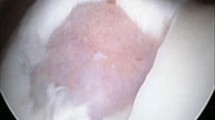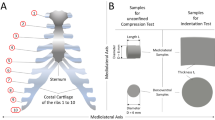Abstract
Tissue banks around the world store human cartilage obtained from cadaveric donors for use in diverse reconstructive surgical procedures. To ensure this tissue is sterile at the time of distribution, tissues may be sterilized by ionizing radiation. In this work, we evaluate the physical changes in deep frozen costal cartilage (−70 °C) or costal cartilage preserved in high concentrations of glycerol (>98 %) followed by a terminal sterilization process using ionizing radiation, at 3 different doses (15, 25 and 50 kGy). Tension and compression tests were carried out to determine the mechanical changes related both to the different preservation methods and irradiation doses. For both methods of preservation, tension strength was increased by about 24 %, when cartilage tissue was irradiated with 15 kGy. Deep frozen samples, when irradiated with 25 or 50 kGy, had a decrease in their mechanical performance, albeit to a lesser extent than when tissues were preserved in high concentration of glycerol and equally irradiated. In conclusion, processing in high concentration of glycerol did not increase tissue protection against radiation damage; while cartilage preserved in high concentrations of glycerol withstands radiation up to 25 kGy, deep frozen human costal cartilage may be sterilized with a doses up to 50 kGy without significant mechanical impact.







Similar content being viewed by others
References
Akal M, Kara M (2002) The use of a homologous preserved costal cartilage in an infant with Poland’s syndrome. Eur J Cardiothorac Surg 21:146–148
Akizuki S, Mow VC, Muller F, Pita JC, Howell DS, Manicourt DH (1986) Tensile properties of human knee joint cartilage: influence of ionic conditions, weight bearing, and fibrillation in the tensile modulus. J Orthop Res 4:379–392
Burke AJC, Wang TD, Cook TA (2004) Irradiated homograft rib cartilage in facial reconstruction. Arch Facial Plast Surg 6:334–341
Cornelissen M, Thierens H, Ridder A (1996) Effects of ionizing radiation on cartilage: emphasis on effects on the extracellular matrix. Scanning Microsc 10(3):833–840
Dziedzic-Goclawska A (2000) The application of ionizing radiation to sterilize connective tissue allografts. In: Phillips GO (ed) Radiation and tissue banking. World Scientific, UK
Dziedzic-Goclawska A, Kaminski A, Uhrynowska-Tyszkiewicz I, Stachowicz W (2005) Irradiation as a safety procedure in tissue banking. Cell Tissue Bank 6:201–219
Feng J, Hu T, Liu W, Zhang S, Tang Y, Chen R, Jiang X, Wei F (2001) The biomechanical, morphologic, and histochemical properties of the costal cartilage in children with pectus excavatum. J Pediatr Surg 36:1770–1776
Getgood A, Bollen S (2010) What tissue bankers should know about the use of allograft tendons and cartilage in orthopaedics. Cell Tissue Bank 11:87–97
Hasler EM, Herzog W, Wu JZ, Müller W, Wyss U (1999) Articular cartilage biomechanics: theoretical models, material properties, and biosynthetic response. Crit Rev Biomed Eng 27(6):415–488
Haviko T, Laasik P (2001) 40 years of tissue banking in Estonia. Cell Tissue Bank 2:173–177
Herson MR, Mathor MB (2006) Bancos de Tecidos. In: Garcia VD, Abud M, Neumann J, Pestana JOM (eds) Transplantes de Órgãos e Tecidos, 2nd edn. Segmento Farma Editores Ltda, São Paulo, pp 174–185
Herson MR, Mathor MB, Pedraza JM (2008) The impact of the International Atomic Energy Agency (IAEA) program on radiation and tissue banking in Brazil. Cell Tissue Bank 10(2):143–147
Komender J, Marczynski W, Tylman D, Malczewska H, Komender A, Sladowski D (2001) Preserved tissue allografts in reconstructive surgery. Cell Tissue Bank 2:103–112
Lexer E (1908) Substitution of whole or half joints from freshly amputated extremities by free plastic operations. Surg Gynecol Obstet 6:601–607
Mann DM, Bertenshaw G, Pearce R, Forng RY, Lin J, Towcimak N, Mulcahy K (2005) High doses of gamma radiation are both necessary and feasible when sterilizing allograft tissues with gamma radiation. American Association of Tissue Banks. 29th Annual Meeting, Hollywood, Flórida
Oguzkaya F, Akçali Y (2003) Multiple pellets expectoration: bronchial repair by using a costal cartilage graft. Interact Cardiovasc Thorac Surg 2:268–269
Pegg DE (2006) The preservation of tissues for transplantation. Cell Tissue Bank 7:349–358
Pruss A, Kao M, Gohs U, Koscielny J, Von Versen R, Pauli G (2002) Effects of gamma radiation on human cortical bone transplants contaminated with enveloped and non-contamined viruses. Biologicals 30:125–133
Roth V, Mow VC (1980) The intrinsic tensile behaviour of the matrix of bovine articular cartilage and its variation with age. J Bone Joint Surg Am 62:1102–1117
Strauch B, Wallach G (2003) Reconstruction with irradiated homograft costal cartilage. Plast Reconstr Surg 111(7):2405–2411
The IAEA radiation and tissue banking program [i]: general information about the IAEA program. Avaliable at: http://www.int-tissuebank.com/. Accessed 05 july 2011
The IAEA radiation and tissue banking program [ii]: IAEA training programme in radiation and tissue banking. In: distance learning: the IAEA/NUS curriculum. Avaliable at: http://www.int-tissuebank.com/. Accessed 05 july 2011
Vajaradul Y (2000) Bangkok biomaterial center: 15 years experience in tissue banking. Cell Tissue Bank 1:229–239
Windfuhr JP, Chen YS, Güldner C, Neukirch D (2011) Rib cartilage harvesting in rhinoplasty procedures based on CT radiological data. Acta Otolaryngol 131(1):67–71
Acknowledgments
We would like to acknowledge the SVO for access to tissue donors and for the FAPESP for the financial support (grant no. 2008/10437-9).
Author information
Authors and Affiliations
Corresponding author
Rights and permissions
About this article
Cite this article
Martinho, A.C., Rosifini Alves-Claro, A.P., Pino, E.S. et al. Effects of ionizing radiation and preservation on biomechanical properties of human costal cartilage. Cell Tissue Bank 14, 117–124 (2013). https://doi.org/10.1007/s10561-012-9306-4
Received:
Accepted:
Published:
Issue Date:
DOI: https://doi.org/10.1007/s10561-012-9306-4




